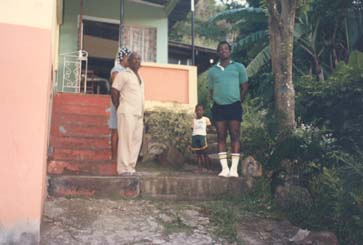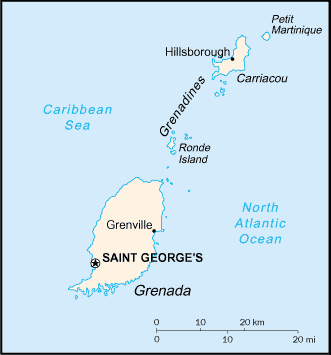|
Crossing the Valley:
|
|
| Return to Daijah's Home Page | 
The man in the green shirt is named Cecil and he is pictured with some of his family members from Grenada. Cecil is a family friend and I have known him for approximately 10 years. He was very interested in doing the interview and invited me to his home one evening so I could ask him some questions. The following are highlights of the interview as well as additional information from course readings which are relevant to the discussion. Why come to the United States People always say to me “Why leave such a beautiful country?” Well, you got to be able to work… you need to progress some way… opportunities are limited… many leave. Grenada has a population of about 90,000. According to the CIA World Factbook in 2000, 32% of the population lived below the poverty line and the unemployment rate was 12.5% Disposable Domestics addresses why people leave their families in Central and South America to find work. This book tells the stories of young women’s migration to the U.S., leaving behind their husbands and children, to become nannies and maids. Middle and upper class families are able to establish their careers and have household obligations fulfilled. This increases the American family’s well being and further disrupts the solidarity of the female immigrants family. Obtaining a Visa Getting a Visa is a long process. I had to go to the American Embassy in Barbados to obtain a student visa. It took about six months for me to finally get it. Once I arrived here I had to renew it every year. My sister had to wait two years before she received her visa. Bridge to America I had an aunt here and my grandmother would travel back and forth from the U.S. to Grenada. My grandmother tried to discourage me from coming here. She would say it’s not as easy as you think, but I wanted to travel. Having a family member already here is helpful to the immigrant’s assimilation. Voyages explained how Tongans will usually move in with a family member when they first arrive in the U.S. Why Migration? Working in a foreign company in Grenada influenced my decision to come to the U.S. I was a telephone operator for eight years. I spoke to a lot of people from England and the United States. I would ask them what to expect and what their country was like. “Strong economic and geopolitical relations between countries of unequal development and unequal job opportunities tend to promote labor migration from poorer to wealthier countries” (Sassen, 1992) Working in a foreign company was a bridge for Cecil. Happiest Moment Buying a house in the United States was very exciting. I honestly didn’t think I would get the loan. In Grenada you might be married with two kids and still live at home with your parents. Having your own home in Grenada is a different process. Basically you are building a shack. First, you buy some land and then gradually buy the materials to build your home. You don’t pay people, just call your friends and they voluntarily will help. Building a home in Grenada is similar to how the Tongan families in Voyages would build their home. Unlike people in the U.S. who pay individuals to assemble their homes, members of the Tongan and Grenadine community are always willing to give their assistance to a neighbor. Owning your own home is also very important to the Hmong. In the book, New Pioneers in the Heartland, the Hmong refugees typically rent old, rundown apartments until they save enough money to buy the more important things in life such as a car or a house. Once they own a home , then they are willing to fix it up. Treatment in the U.S. “Over the past three decades, Asians, Latinos, and Caribbean immigrants have outpaced the number of Irish, Italian and Eastern European immigrants so familiar at the turn of the Century, sometimes prickling racial tensions among native-born Americans” (Clark, 1997) Life in the U.S. is a lot better than I thought it would be. I’m not aware of how other people view me, I don’t feel discriminated against. I have my own business and I have never had any problems. However, many non-Europeans do feel as though they are victims of inequalities like racial profiling. A survey of Arizona residents from four towns next to Mexico, shows 41-77% of residents “believe that racial profiling happens in their community.” ( Justice on the Line, 2003) “ I have been stopped more than twenty times from the time that I was thirteen years old up to today at fifty years old. I am a naturalized citizen and they constantly stop me in the city and on the road. They never give me a reason. They ask for my immigration documentation. Sometimes they ask who owns my vehicle, where am I going, where did I come from” -- Hispanic women from Nogales (cited in Justice on the Line, 1997)
Border Action Network, Justice on the Line 2003 Charles S. Clark, The New Immigrants, Congressional Quarterly Researcher Jan 24, 1997:49-72 (reprint in Annual Editions: Race & Ethnic Relations 2000) Cathy A. Small, Voyages: From Tongan Villages to American Suburbs. Cornell UP 1997 Crace Chang, Disposable Domestics: Immigrant Women Workers in the Global Economy. South End Press 2000 Jo Ann Koltyk. New Pioneers in the Heartland: Hmong Life in the Wisconsin. Allyn & Bacon 1998 Saskia Sassen. Why Migration? Report on the Americas 25(1) 1992: 14-19
|
| Return to Migration & Culture home page | |

 In and Out of
Grenada
In and Out of
Grenada